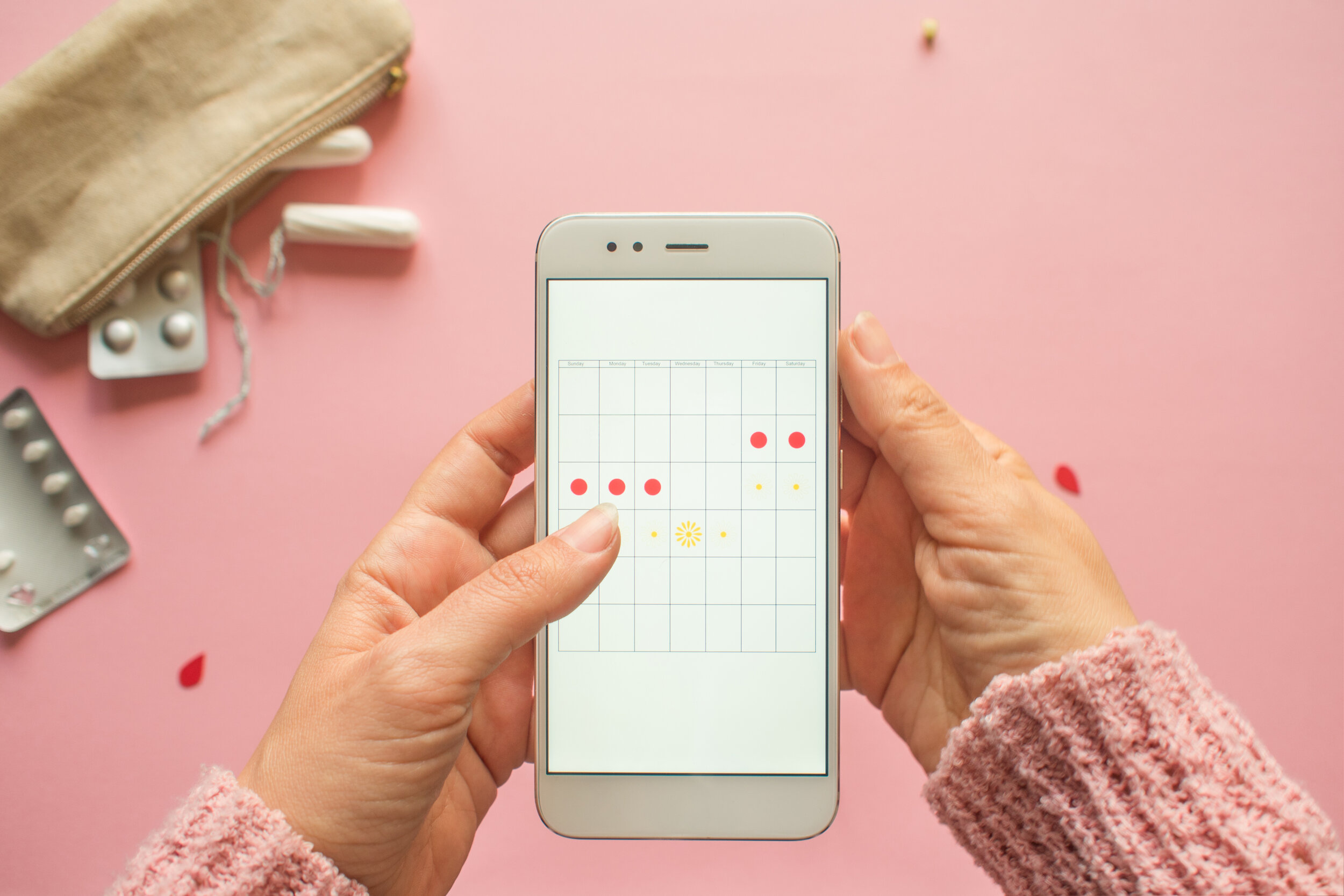What is the deal with Ovulation?
How to tell you ovulated and why it matters, even if you are not trying to get pregnant.
When did you start to care about your cycle in general, let alone ovulation? For many ovulation only came on their radar once they considered trying to conceive. With many individuals not looking more in-depth at their cycle unless they had difficulty getting pregnant. Despite what we learned in high school a woman cannot get pregnant every day of her cycle. A woman is only fertile for a limited amount of time each cycle and that time is determined by ovulation.
So why do care if you ovulated if you are not trying to get pregnant or have no risk of getting pregnant? Well, right after ovulation the corpus luteum is formed. This newly formed structure releases a lot of progesterone, which otherwise is only produced in a small amount from the adrenal gland. If there is no ovulation, there is no increase in progesterone production! This obviously matters for fertility, but also for general health. Ovulation is also a normal healthy process and the lack of ovulation or a period can be a sign of a deeper issue (see below).
Why you want progesterone
When it comes to fertility progesterone is key! Progesterone helps the body prepare, hold and nourish a pregnancy. But the balance between progesterone and estrogen does so much more than just aid in pregnancy.
Progesterone and estrogen are two hormones that are meant to be in balance and work together. They ensure your uterine lining is thick enough, but not too thick (no one wants a super heavy period). They each have an opposite influence on your thyroid hormone, which we don’t want too much or too little of. One role of progesterone that is often forgotten is its benefit to mental health.
Progesterone is metabolized in the body to allopregnanolone (among other things). Reduced levels of this metabolite have been found to be associated with depression and anxiety disorders, PMS, PMDD (premenstrual dysphoric disorder), and postpartum depression among other mental health concerns. Allopregnanolone is known to work on GABA receptors in the brain, but research is now showing that it may support mental health in other ways as well, including regulation of your HPA and your ability to adapt to stress.
How to tell if you ovulated
One of the best ways to confirm ovulation, outside of testing or ultrasound, is through tracking basal body temperature (BBT). Progesterone, released only after ovulation occurs, raises our body temperature slightly – approximately 0.3 degree Celsius (or 0.5-1 degree Fahrenheit). This rise in temperature will remain throughout the luteal phase, until menstruation (if no pregnancy occurs) where it will then return to baseline.
Basal body temperature is the lowest natural, non-pathological body temperature recorded after a period of rest. It is recommended that you record your BBT first thing upon waking, before anything else, ideally at a consistent time each day. Technology has made this easy with there now being many devices available that are able to track and connect to an app for you to observe the results and trends (this includes things like a thermometer to the oura sleep ring, amongst many others).
To confirm ovulation a progesterone blood test can be done on day 21, or about 1 week before the expected period if you have a longer cycle. (An at-home testing option is discussed later on)
Signs of ovulation:
Due to the changes that occur in the body around ovulation, there are some physical indicators that you should be aware of to help track yourself.
· Due to a rise in estrogen prior to ovulation there is a shift in cervical mucous that can be spotted, you may notice an increase in vaginal discharge that resembles raw eggs white
· Some women may experience mild cramps during ovulation, known as mittelschmerz cramps
· Mild breast tenderness can also be considered a normal sign of ovulation
Ovulation / LH Strips
Despite the name conventional ovulation strips do not actually detect ovulation. What they do detect is luteinizing hormone (LH). The strips have a certain threshold and when enough LH is detected in the urine you get a positive reading. A spike of LH from the brain triggers the ovaries to ovulate and release an egg, this usually happens about 24-48 hours after the LH rise. When trying to conceive these LH strips can be very helpful as they can help guide couples for timing of intercourse. Since sperm can live for much longer than an egg, it is helpful to basically have the sperm waiting for the egg. But just because you see a positive test result, it does not necessarily mean ovulation will occur. For example, those who suffer from PCOS, where the LH is chronically elevated these strips may not be a good option as they can be very misleading.
For those looking to confirm ovulation there has been some at home kits created which detect a progesterone metabolite in the urine, remember progesterone is only released after ovulation has occurred. An example of this is the Proov test.
Your goal matters
If you are looking to confirm ovulation for general health reasons then basal body temperature or a progesterone test is sufficient. However, if your goal is around fertility (either preventing or promoting pregnancy) then you want to look for indicators that occur prior to ovulation. Paying attention to these changes and markers can help you determine your fertility window, with the potential start being the first signs of ovulation (cervical mucous, a positive LH reading, etc) and the close of your window being a rise in BBT or a confirmation of progesterone.
Not sure if you ovulated – now what?
First of all, reach out to your health care practitioner, as they will be able to help you start some further investigation – usually starting with a progesterone blood test to assess your ovulatory status. If ovulation does not occur, yet you still a bleed/period, this is referred to as an anovulatory cycle. Some women instead experience amenorrhea, which is a lack of bleeding altogether. Anovulatory cycles and amenorrhea are not disorders themselves but rather signs of another issue.
There are a number of causes/factors that can lead to a lack of ovulation. It is best to work alongside a healthcare provider to determine what is happening in your scenario (don’t have one? – reach out here).
Here a few potential causes:
· Pregnancy, lactation or menopause (these should be ruled out first)
· Dietary restriction and/or excess exercise
· Stress
· Changes in routine
· PCOS (Polycystic ovarian syndrome)
· Thyroid dysfunction
· Medications
o It is important to note, that the birth control pill functions by suppressing ovulation. If on a hormonal IUD, some women may still ovulate while others will experience suppression of ovulation.
Some final thoughts
Ovulation is one of four key parts of the menstrual cycle, yet is one that many do not know how to identify, even in their own body. By being aware of your ovulation, or lack of, it empowers and gives you a greater understanding of your body. My goal is that you understand all the workings of your body and the signs to look out for.
If you are interested in working together, click here to book in now.
Disclaimer
Information can be empowering, but we all have unique health profiles and needs. Health-related information contained in this post is intended to be general in nature and should not be used as a substitute for visiting a Naturopathic Doctor. This article was written for information purposes only and was not intended to diagnose or prescribe. The above advice is intended to only offer a general basis for individuals to discuss their medical condition with their health care provider. Always consult your licensed physician
References
Rebar R. Evaluation of Amenorrhea, Anovulation, and Abnormal Bleeding. [Updated 2018 Jan 15]. In: Feingold KR, Anawalt B, Boyce A, et al., editors. Endotext [Internet]. South Dartmouth (MA): MDText.com, Inc.; 2000-. Available from: https://www.ncbi.nlm.nih.gov/books/NBK279144/
Schumacher M, Mattern C, Ghoumari A, Oudinet JP, Liere P, Labombarda F, Sitruk-Ware R, De Nicola AF, Guennoun R. Revisiting the roles of progesterone and allopregnanolone in the nervous system: resurgence of the progesterone receptors. Prog Neurobiol. 2014 Feb;113:6-39. doi: 10.1016/j.pneurobio.2013.09.004. Epub 2013 Oct 27. PMID: 24172649.
Schüle C, Nothdurfter C, Rupprecht R. The role of allopregnanolone in depression and anxiety. Prog Neurobiol. 2014 Feb;113:79-87. doi: 10.1016/j.pneurobio.2013.09.003. Epub 2013 Nov 8. PMID: 24215796.
Steward K, Raja A. Physiology, Ovulation And Basal Body Temperature. [Updated 2020 Jul 27]. In: StatPearls [Internet]. Treasure Island (FL): StatPearls Publishing; 2021 Jan-. Available from: https://www.ncbi.nlm.nih.gov/books/NBK546686/
Su, H.‐W., Yi, Y.‐C., Wei, T.‐Y., Chang, T.‐C. and Cheng, C.‐M. (2017), Detection of ovulation, a review of currently available methods. Bioengineering & Translational Medicine, 2: 238-246. https://doi.org/10.1002/btm2.10058


